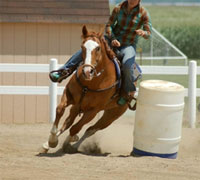
Q: My barrel racing gelding is generally sound and healthy and I want to keep him that way. He’s 16 now, and I am concerned about keeping his joints healthy. Is there anything I can do to help preserve his joints?
Skeletal joints are a surprisingly complex anatomical entity. These joints have evolved to not only allow for smooth bodily movement, but also to create a shock-absorbing mechanism. DJD develops as this shock-absorbing mechanism breaks down in mainly two ways: by the wearing down of the articular (joint) cartilage which lines the ends of bones when they meet at a joint, and by the decrease of synovial fluid, which is the viscous, highly protective fluid within a joint that provides lubrication for movement and nourishment to the tissues within.
Most people in the horse industry are familiar with joint supplements and this is often the first line of defense when it comes to helping prevent the development of equine arthritis. There are many oral products on the market now to help sustain the cartilage and synovial fluid of a horse’s joints and they are labeled as chondroprotectants (the prefix chondro- means “relating to cartilage”). Most of these products contain chondroitin sulfate, glucosamine, or hyaluronic acid and sometimes combinations of these. Each of these ingredients is a building block for articular cartilage so adding them to your horse’s diet can help maintain the cartilage he already has and help repair cartilage that is slightly worn. Many of these chondroprotectants are labeled as everyday additives in your horse’s feed and for true effect, should usually be added as a constant supplement, year round. There are many brands on the market, so be knowledgeable about what you are buying – these supplements are not regulated by the FDA and therefore each brand can have varying concentrations of the key ingredient. Enlist help from your veterinarian when picking out which one is best for your horse.
There are also injectable joint supplements on the market. These supplements were developed to circumvent the sometimes incomplete gastrointestinal absorption of oral supplements. Intramuscular (IM) and intravenous (IV) injections of polysulfated glycosaminoglycan (Adequan) and hyaluronic acid (Legend), respectively, are available with much higher concentrations of active product than the oral supplements and therefore can be given less frequently, however they can be more expensive and require either a veterinarian or someone with experience giving IM or IV injections to administer them to your horse.
Other management practices you can easily implement to help prevent arthritis in your gelding include regular exercise and proper hoof care. Regular exercise helps maintain robust circulation to your horse’s joints, which helps maintain joint health. Regular exercise also helps keep your horse at an appropriate body weight – overweight horses place greater stress on their joints. Regular trimming of your horse’s hooves helps maintain hoof balance. Unbalanced feet can cause undue stress on joints, a pre-cursor to arthritis. Regular and proper shoeing, if your horse requires it, should also be maintained.
Other more aggressive forms of arthritis management, such as joint injections comprised of corticosteroids and hyaluronic acid and shockwave therapy, are also available for those horses training heavily or already showing signs of decreased performance due to DJD. Fortunately, good arthritis management starts with prevention. Ben Franklin’s quote, “an ounce of prevention is worth a pound of cure”, could not be truer when it comes to DJD.
Ask your questions on the HorseChannel.com Forums >>
See more Expert Q&As >>
Submit your Ask the Expert question >>







I did talk to my vet about this very same subject, and was told that the supplements for joints are about the same, they work on some horses and not others, so how would a person really know if the prevention supplements will work or not??
GOOD QUESTION PKL. ALSO, AT WHAT AGE IS A GOOD AGE TO START PREVENTATIVE SUPPLEMENTS? DOES IT MAINLY DEPEND ON THEIR ACTIVITY/COMPETITION LEVEL, OR IS THERE A GENERAL AGE?
IT WOULD BE NICE TO HAVE A CHART WITH RESULTS FROM STUDIES OF DIFFERENT JOINT AND JOINT/COMBO SUPPLEMENTS. THAT WAY WE COULD SEE HOW THEY PERFORM, THE TOP BRANDS AND THE CHEAPER BRANDS. NOT ALL OF US CAN AFFORD THESE TOP DOLLAR SUPPLEMENTS. (SUCH AS PLATINUM PERFORMANCE) SO SEEING WHAT LESS EXPENSIVE BRANDS DO ACTUALLY HELP WOULD BE NICE. YES, WE ALL WANT THE BEST FOR OUR HORSES, BUT WE DONT WANT TO GO MORE BROKE THAN WE ALREADY ARE TRYING TO CARE FOR THEM.
PKL & TRAIL RIDER:
Joint supplements such as msm and glucosamine are excellent to aid in the prevention and treatment of joint diseases, injuries, etc. and you don’t have to break your budget to get them. You can get inexpensive brands and, for prevention, feed your horse the recommended daily dose on the label. But if the horse already has a joint issue, his body may need more than the recommended dose to reverse the issue-which still does not have to be expensive. A $15 container of msm lasts my 2 horses almost a month.
I guarantee that joint supplements will work for any horse-as long as the horse is given the correct amount for his needs. For example, say you have a 1,300 pound large draft breed with arthritis and you give him the recommended daily dose on the label of a container of msm. You don’t notice any change in his arthritis since you’ve been giving the msm. That is because the recommended dosage is for an average sized 1,000 pound horse, and because you have a large horse and you are giving him msm to Treat the arthritis, he would probably need twice the recommended dosage. This can be the same with an average sized horse, because some horses’ bodies just require more of a certain nutrient to aid in the treatment of a disease or injury-the recommended dosage on the label is a General guidline for Most horses. Another example, my 20 year-old, 15 hand, between 900 and 1,000 pound horse had mild arthritis throughout his whole body. Through the use of massage, giving him twice the recommended dose of msm, and two tablespoons of apple cider vinegar (which is good for the joints) every day, it only took a few months before the arthritis was completely reversed.
As for the age to start a horse on preventative supplements, any age. The sooner the better. The amount you give them does sometimes depend on their activity level, though. For example, a barrel racer would need more msm (or whatever joint supplement you are using) than a pleasure horse.
I hope this helps you both and let me know if you have any more questions!
HI LEXI, THANKS FOR YOUR COMMENT AND EXPLAINING YOUR EXPERIENCE, AND THOUGHTS, WITH THE MSM. I SEE MYSELF STARTING MY HORSE ON A PREVENTATIVE JOINT SUPPLEMENT (BEFORE ANY JOINT ISSUES START!) IN THE NEAR FUTURE!
You’re very welcome, TRAIL RIDER. Glad I could help. A lot of supplements are less expensive online than at a tack store, but you have to remember shipping costs too.
Do you have a profile on Horse Channel?
This is a great artical
HI AGAIN, LEXI. YEP, I DO HAVE A HC PROFILE. 3 ACTUALLY. IM NOT ON THE PROFILES MUCH, JUST HERE AND THERE. I MAINLY CHECK THE HOMEPAGE OF NEWS AND TIPS. BUT HERE’S MY HORSE’S PAGE NUMBER ANYWAYS, #191394. STOP IN SOMETIME!! (DONT FORGET TO TELL ME WHO YOU ARE IN YOUR COMMENT!)
My horse is only 6 years old. He gets daily exercise and is quite fit but not an extreme athlete. I would like to do preventative care for his joints but should I really start this early? Or could I wait till he is in his teens?
M S,
It is never too early to start your horse on a joint supplement, and it could prevent serious issues for the horse later on, as even 6 year-olds can get arthritis or other joint issues. The best preventative supplement you can give your horse is pure msm. It does not have to be expensive either; one $15 container of msm lasts me about a month for 2 horses. Glucosamine is excellent as well. I hope this helps!